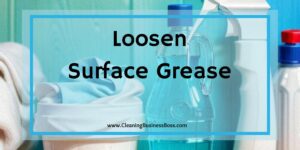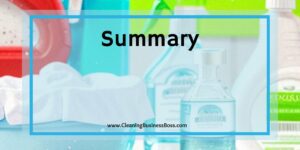Many different aspects can define a cleaning business. However, the one aspect in which you should be most consistent is in your cleaning procedure. By remaining consistent in your cleaning procedures, you will ensure that your customers receive a professional and thorough cleaning each time you clean. Following these steps will not only result in satisfied clients but will also secure your cleaning service with repeat business and word-of-mouth recommendations for years to come.
There are six basic steps to promote proper cleaning and disinfecting procedures. They are:
- Give a good pre-cleaning by sweeping, wiping, and rinsing floors and general surface areas.
- Use detergents and cleaners to loosen surface grease.
- Remove excess Grease, cleaners, detergents, and food waste with a thorough rinsing.
- Use disinfectants to kill bacteria on surfaces.
- Remove the disinfectants with a final rinsing.
- Remove excess moisture with proper drying.
Give a Good Pre-Cleaning
A thorough top-to-bottom cleaning starts with a good pre-cleaning. While this step may sound slightly redundant, I assure you that it is essential. A good, proper cleaning usually starts with an initial wiping and rinsing of general surface areas such as countertops. Want you have given these surface areas a good once over, you can complete the pre-cleaning phase of the cleaning procedure by sweeping the floors. This ensures that all debris is removed from any hard surface area.
However, you will always want to make sure that you sweep after wiping down hard surface areas. While this may seem self-explanatory, the reason for this is because you do not want to sweep the floor and then get food particles and other debris on the floor once you wipe all the surface areas in the home. This is counter-intuitive in the sense that it will only make you spend more time cleaning, as you will have to sweep a second time.
Is cleaning business profitable? Check out this article to know the answer.
Loosen Surface Grease

Once you have moved on from the pre-cleaning phase, it’s time to loosen surface grease with a good spray cleaner or degreaser. Most of us know that it takes at least two to three wiping things before you can remove all traces of Grease on your countertops, stoves, and other hard surfaces in your kitchen. Taking this extra step will provide your customers with the sparkling clean surfaces they expect from your cleaning business.
As I’m sure you are already aware, the stove is the one place in the home that attracts the most Grease and grime. Rarely is it that a single wipe down is sufficient for removing said Grease. You can loosen the surface Grease on kitchen counters and stovetops with a good degreaser, making sure that it will be spotless and safe for your clients to use for cooking their meals.
Give a Thorough Rinsing
After you have finished the pre-cleaning and loosening phases of your cleaning procedure, it’s time to rinse away any excess cleaners or degreasers which may have been left behind. No matter how thorough your cleaning job may be, it will not be up to the customer’s standards if you leave traces of cleaner on their kitchen counters, bathroom sinks, etc. A good general rule of cleaning is to leave nothing behind. A good sparkle and shine should be the only traces that you were ever there.
While a thorough rinsing may initially seem a bit time-consuming, it is an absolute necessity when providing your clients with a professionally cleaned home. An excellent example of a thorough rinsing would be using warm water to wipe down kitchen countertops and bathroom counters after using harsh cleaners. Taking this extra step will ensure happy customers by providing them with a job well done.
Kill Surface Bacteria
A good, fresh cleaning does more than leaving your house sparkling and smelling great. The purpose behind cleaning is to remove any trace of bacteria that may be lurking throughout the customer’s house. Using an industrial-strength disinfectant will ensure that you remove this bacteria from every room and your client’s home, including the bathroom and kitchen.
We have all heard that the kitchen and the bathroom or the two dirtiest rooms in the home. This is due to the accumulation of bacteria in both rooms. Contrary to popular belief, the kitchen is the dirtiest room in the home. Properly disinfecting kitchens and bathrooms in the home will provide your customers with the peace of mind that they hired your cleaning business in the first place.
Perform a Final Rinsing

Upon removing bacteria from your clients’ homes, the next step in your cleaning procedure should include rinsing the disinfectants you use from their hard surface areas. While disinfectants are quite effective in killing and removing bacteria, they are especially harmful to pets and small children. By thoroughly rinsing disinfectants from your clients’ homes, you are taking an extra precautionary step towards their well-being.
Think of any pets or children you may have. Now, think of how important they are to you. Your customers feel the same way about the safety of their pets and children as you do toward yours. Performing a final rinsing, removing all traces of harmful cleaners, shows your clients that you care about their safety and the safety of their families as well. Take the time to rent surfaces in your clients’ homes with warm water.
Check out this article to know how long will it take you to clean a five bedroom house.
Give a Proper Drying
Moisture can be a breeding ground for many types of bacteria and mold. This is why proper drying is one of the most important aspects of the cleaning procedure. Your clients do not expect to find bacteria and mold in their homes or businesses once you are done cleaning. Make sure to dry all surface areas such as kitchen and bathroom counters, as well as floors after you are done.
USB just finished cleaning a customer’s home. The last thing you want to happen is to field a complaint that mold or bacteria is growing where you just finished cleaning. Make sure to use a dry cloth, vigorously wiping down dishes, countertops, and any other surface area which may have gotten wet during the cleaning process. Be sure to use a fresh towel for each surface or area you wipe dry.
Summary

A prosperous business consists of many key components. Two of the essential components are a professionally done job and satisfied customers. By following the proper cleaning procedure, your cleaning service provides not only excellence but also consistency in serving your customers. Satisfied customers are usually repeated customers. As repeat customers generally produce a much healthier bottom line, you might say that the survival of your cleaning business depends on making your customers happy by following proper cleaning procedures.
Frequently Asked Questions
What is considered to be a good profit margin for a cleaning business?
Cleaning businesses, like any other business, need to have a healthy profit margin if they expect to remain in business. To calculate profit margin, simply divide your net income by your revenue and then multiply that figure by 100. Per Bizfluent.com, a healthy profit margin for a home cleaning business is approximately 48%. Of course, this is due to the relatively low overhead expenses and minimal labor costs. However, a good profit margin for a successful commercial cleaning business is around 28%, per Cleaning Business Boss.
What are the operating expenses associated with owning a cleaning business?
A cleaning service, whether it is commercial or residential, is an easy and inexpensive way to start your own business. However, you are going to have operating expenses associated with owning a cleaning service, as you will with any other business. Unfortunately, operating expenses are unavoidable. However, you can do your part to reduce them as much as possible. The website Camino has listed the following operating expenses associated with owning a cleaning business:
- Business licenses, registration, and required permits
- The cost of cleaning supplies
- Insurance costs
- Labor costs
- Rent or mortgage on office space
- Office supplies and technology
What are a few good tips for reducing overhead costs for my cleaning business?
Everybody, whether they are a business owner or not, likes to save money. Cleaning business owners are no different. By reducing overhead costs and operating expenses, their profit margins increase, and their bank accounts will thank them for it. One helpful tip and reducing overhead cost is to purchase your cleaning supplies when they are on sale.
Buying cleaning supplies in bulk will usually help you to save a little money as well. Another way to reduce overhead costs for a cleaning business is to carefully watch the amount of time it is taking you or your employees to finish a cleaning job. The more time you waste, the more expensive your labor is going to be. One final way to reduce overhead costs for your cleaning business is to be mindful of the number of cleaners you are using. Remember the old saying, “Waste not, want not.”
To learn more on how to start your own cleaning business, check out my startup documents here.
Please note that the contents of this blog are for informational and entertainment purposes only and should not be construed as legal advice. Any action taken based on the information provided in this blog is solely at your own risk. Additionally, all images used in this blog are generated under the CC0 license of Creative Commons, which means they are free to use for any purpose without attribution.

About the author. Entrepreneur and Cleaning Business Fan.
Hi! I am Shawn and I am a happy individual who happens to be an entrepreneur. I have owned several types of businesses in my life from a coffee shop to an import and export business to an online review business plus a few more and now I create online cleaning business resources for those interested in starting new ventures. It’s demanding work but I love it. I do it for those passionate about their business and their goals. That’s why when I meet a cleaning business owner, I see myself. I know how hard the struggle is to retain clients, find good employees and keep the business growing all while trying to stay competitive.
That’s why I created Cleaning Business Boss: I want to help cleaning business owners like you build a thriving business that brings you endless joy and supports your ideal lifestyle.


